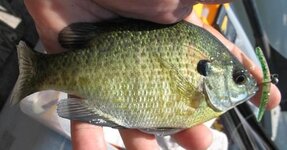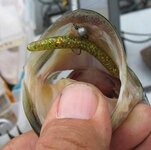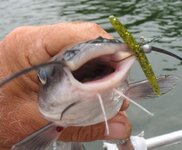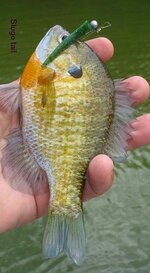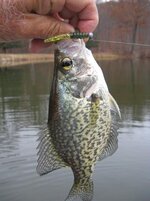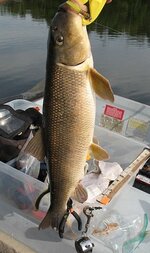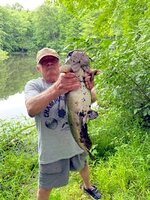Ever since I caught my first bass on a GY Senko I wondered why that lure is amazing. I noticed the plastic is of some formula that cause it to sink faster than most any plastic could given the same shape: a
thin stick with
blunt tips. Gary Y somehow figured out the hydrodynamic properties of the design and made a killing. For a lure crafter and designer such as myself, it opened some doors regarding soft plastic
tail designs that took into consideration how lures move differently given different presentations. There is no advantage to having a huge variety of lures that do equally well given conditions, but I can always pretend that many of my creations do well because they are different than most soft plastic sold.
My first grub was a bright yellow Mr Twister Grub given to me by a tackle shop owner. I was blow away by the smallmouth it caught ! You see the tail flapping and figure that fish must thing the grub represents another fish. Course that doesn't explain Mr Twister's Phenom worm especially with a purple body and pink tail.
No lure in nature looks nor moves like that! But hey if it catches fish, there's got to something fish are thinking about when they bite certain designs.
But getting back to the Senko. A few years ago I accidentally fashioned a stick-grub by accident and to this day have no idea how it ended up
in my tackle box. But there it was and what the heck - why not rig it on a ball head jig like any other grub. This was the first fish of over two dozen it caught that day:
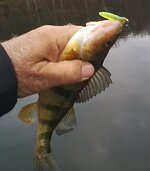
Now I'm confused ! The tail is blunt, the surface of the lure is smooth as glass and fish blasted it. Finally I watched it in the water using the usual rod tip twitches for finesse lure and
DANG if it didn't wag back & forth like a miniature Zara Spook surface plug - except underwater !!
A lure's action speaks louder than words and like all other great lures, lure action is 3/4 the reason fish attack them.
So as is my nature after catching a bunch of fish on a new discovery, I went wild coming up with
short stick grubs cut from different sources and added them to 1/16 oz ball head jigs. Here are a few:
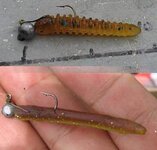
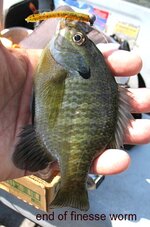 Then I figured : why does a stick grub have to have rounded sides ? Enter the stick grub with four flat sides (note the grub holder wire):
Then I figured : why does a stick grub have to have rounded sides ? Enter the stick grub with four flat sides (note the grub holder wire):

It did as well as any other mini-stick.
Last year I started making
transparent plastic sticks with glassy smooth sides and blunt tail. They did great in any color water:
 Different diameters (above picture) were tested and all caught fish.
Different diameters (above picture) were tested and all caught fish.
But before that I figured - why not make a bullet shaped grub which a call a cone tail grub.
[size=small]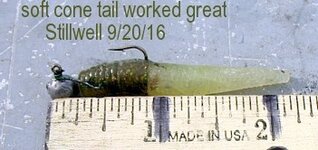
[/size]
[size=small]It caught this 4 lb catfish and a three other species:[/size]
[size=small][size=small]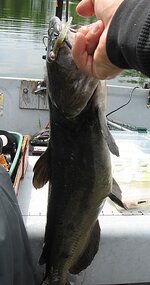 [size=medium]
[size=medium] [size=small]
[size=small]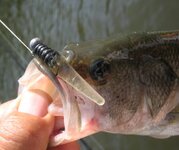
[/size][/size][/size][/size]
[size=small][size=small][size=medium][size=medium][size=medium] ^Even this little guy wanted a piece of one ^ and this bass[/size][/size][/size][/size][/size]
[size=small][size=small][size=medium][size=medium][size=medium][size=medium]Back to short sticks. Again I have no idea how or when I made this 2.5" stick grub, but when I saw it laying on my craft table I figure, [/size][/size][/size][/size][/size][/size]
[size=small][size=small]why not wacky rig it with a 1/32 oz jig and see how it falls in the water. UNBELIEVABLE ! It had the same tip and body wobble on the drop as a 4" [/size][/size]
Senko ! and caught fish the first time I took it fishing. Here is the first prototype:
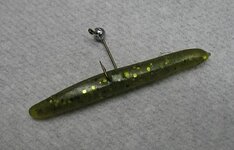 For a faster drop but with still the same action, a 1/16 or 1/24 oz ball head jig was used.
note: a jig must be used considering the light weight of the plastic in order to start the lure wobble and tip gyrations on the drop.
note: the lure can be rod tip-twitched mid-depth anywhere to the bottom.
I have bags of never used curl tail grubs so I figured: why not cut of the tails and weld the bodies together using a candle flame:
[size=small]
For a faster drop but with still the same action, a 1/16 or 1/24 oz ball head jig was used.
note: a jig must be used considering the light weight of the plastic in order to start the lure wobble and tip gyrations on the drop.
note: the lure can be rod tip-twitched mid-depth anywhere to the bottom.
I have bags of never used curl tail grubs so I figured: why not cut of the tails and weld the bodies together using a candle flame:
[size=small] [size=small]
[size=small]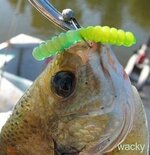 [size=small]
[size=small]
[/size][/size][/size]
[size=small]They all work great ! (Note the different jig rigs in the two photos on the right.)[/size]
[size=small]Don't forget cone tail sticks - another tried & proven design:[/size]
[size=small][size=small]
[/size][/size]
[size=small]Thanks Gary Yamamoto ! It was a pleasure learning the secret of the Senko and taking it from there![/size]
[size=small]Also, thanks for the digital camera and a place to store photos to transfer from.[/size]
